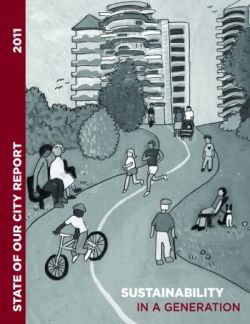
Dr. Noel Keough, environmental design assistant professor of sustainable design and co-founder of Sustainable Calgary (SC) recently authored the organization’s 2011 State of Our City Report. The report takes an in-depth look at Calgary’s living environment, applying sustainable indicators such as housing affordability, transit usage, volunteerism, bird population surveys to track the long-term health and vitality of the city. Founded in 1996 as a grassroots movement concerned with improving the sustainability of the city, SC engaged local citizens in redefining how progress in Calgary is measured. Traditionally narrow economic indicators have driven public policy-making measuring factors such as economic growth, stock market indexes and currency valuations. SC has been striving to change all that. The initial enthusiasm of the movement led to the establishment of 36 community sustainable indicators. Indicators that SC and its supporters think should be used to measure progress in the city. It is these key indicators that are used to outline the 2011 State of Our City Report. The release of SC fourth report comes during a time when sustainability issues have become an overarching theme, driving debates at City Hall over how to evolve Calgary into a more vibrant place to live. Despite the city’s desire for progressive change and roadmaps for doing so, the report indicates that only baby steps are being made. Two critical challenges have been identified. First, we live in a city where inequality persists and is deepening. Second, we continue to pursue a lifestyle that consumes far too many of the earth’s resources. We live hard and fast in Calgary and too many vulnerable people and too much of the natural world gets trampled in the process. Despite such ongoing challenges, Keough acknowledges that Calgary has made some progress toward sustainability. “Population density has begun to trend higher in the past couple of years after reaching historic levels of sprawl in the mid-2000s. We are seeing transit usage continue to modestly increase, specifically for the downtown commute. Our ecological footprint however, is four times what is fair and sustainable, although it is showing signs that it may be peaking.” There is room for optimism. Calgarians are showing increasing concern and recognition for our natural environment. The big question is will we be able to move this into action fast enough? One thing SC has learned over the last decade is that they will not achieve their vision of a sustainable city without the buy-in and participation of Calgarians. The report urges Calgarians to learn more about the issues highlighted in the report. Talk to friends and neighbours, and let your views be known to your School Board Trustees, Councillor, MLA and MP. Get involved with citizen groups and community associations that contribute to Calgary achieving sustainability in a generation and make your voice heard. Only through collective action will change be made.

